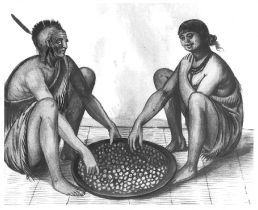
The Bear River American Indian people, were an Algonquian tribe also known as the Bay River people. They lived primarily between the Pamlico and Neuse Rivers in the late seventeenth and early eighteenth centuries. They were neighbors of the Pamlico people, and there is some evidence they were related to the Machapunga people. Both the Bear River and Pamlico people were likely descendants of the American Indian people that the Raleigh colonists of 1585-86 found living in the area. In 1709, the Bear River people occupied a single town, Raudauquaquank. About fifty Native soldiers were documented as living in this town.
The colonists complained of depredations and threats from this tribe, which apparently helped preluded the massacre that began the Tuscarora War (1711-13). During that uprising, colonial leaders enslaved a number of the tribe's women and children, and the Bear River chief was tortured to death by other tribes allied with the colonists. At the end of the war, the Tuscarora turned on their former allies, promising in the peace treaty to destroy them, sparing no males more than fourteen years old.